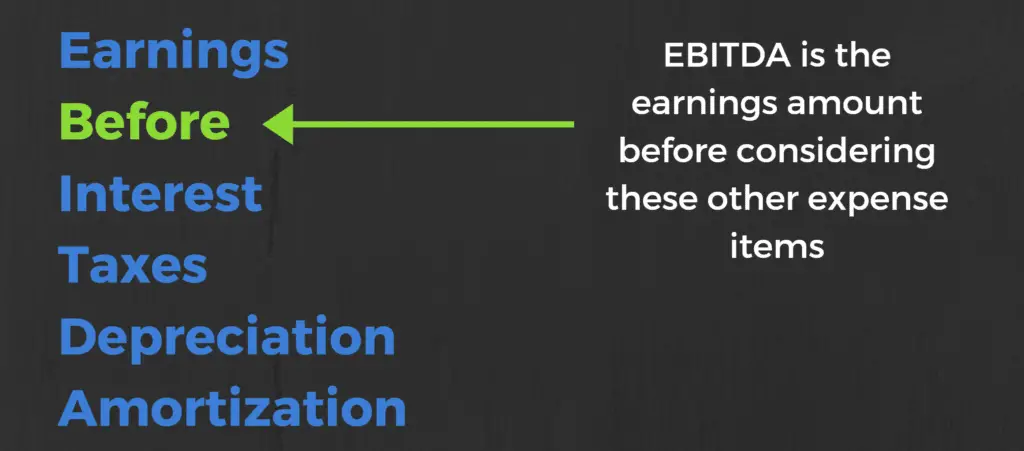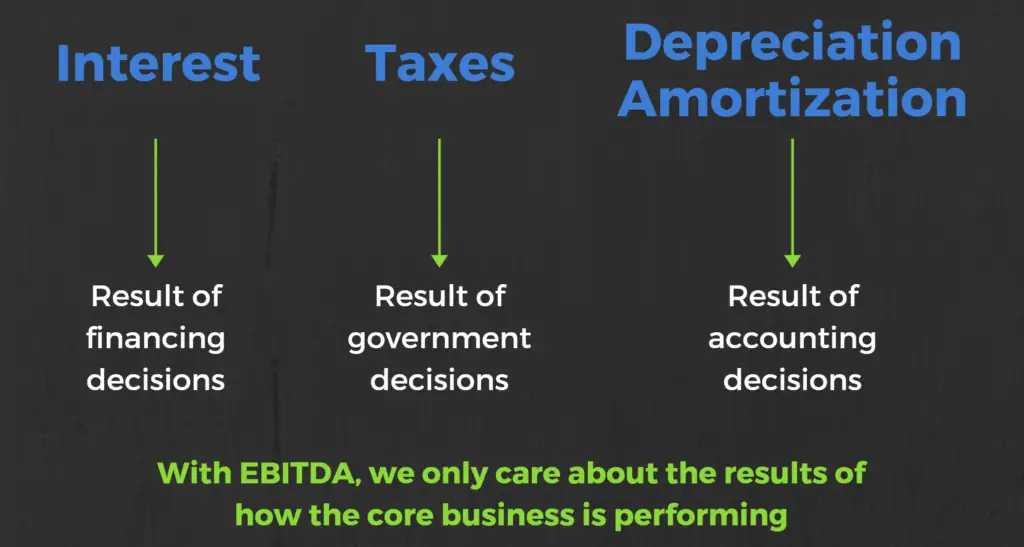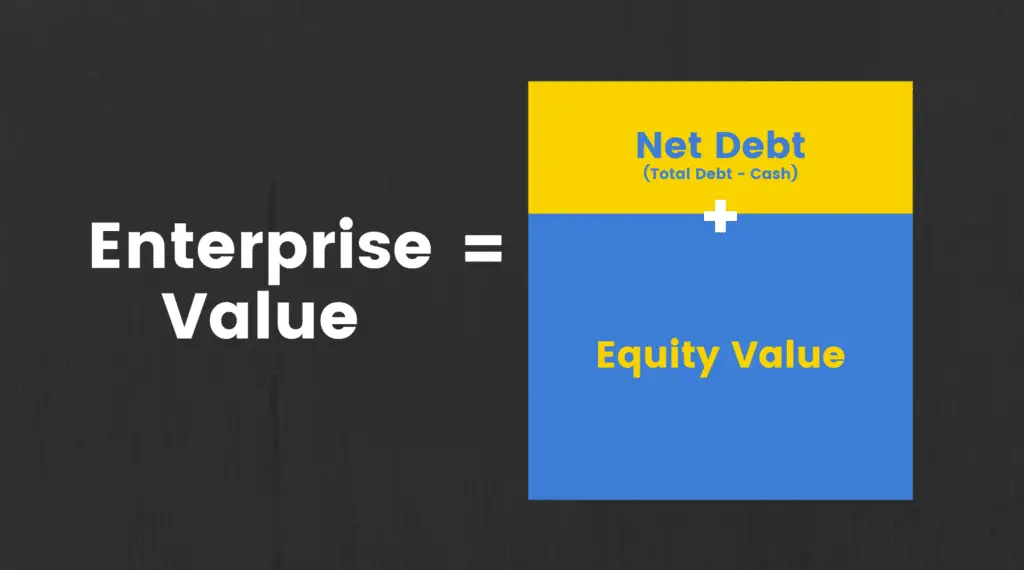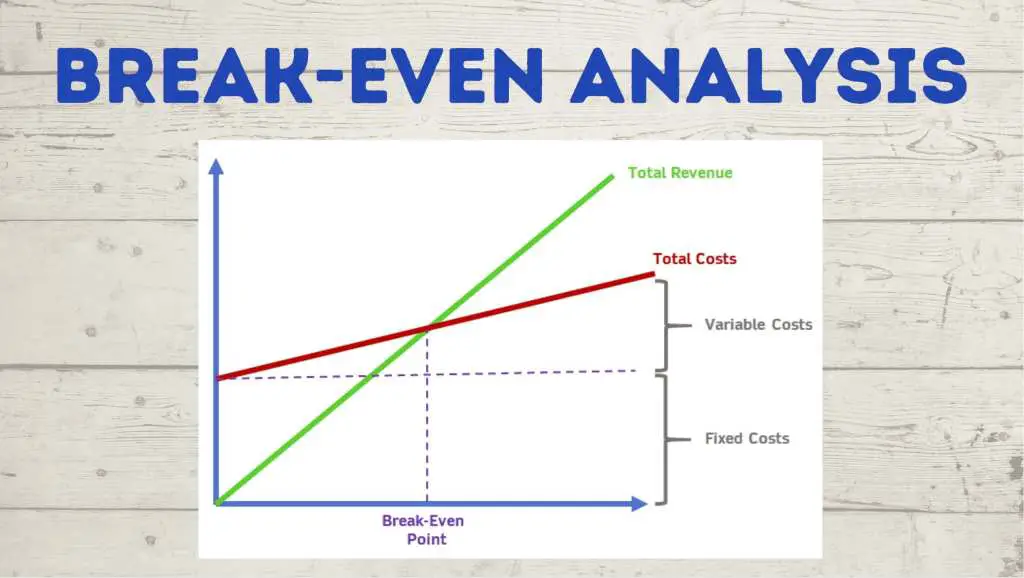This post may contain affiliate links, which means I’ll receive a commission if you purchase through my links, at no extra cost to you. Please read full disclosure for more information.
WHAT IS EBITDA?
EBITDA is a measure of profitability and is used to evaluate a company’s financial performance. It is used frequently by analysts and investors as an alternative to looking at net income/earnings because the metric focuses on the profitability of a company’s core operations.
It dials in on the operations by stripping out the effects of non-operating items such as interest, taxes, depreciation, and amortization. Hence the acronym EBITDA.
EBITDA stands for “Earnings Before Interest, Taxes, Depreciation, and Amortization.” When looking at the EBTIDA of a company, you are looking at the earnings before considering those other items that are unrelated to management’s decision-making and execution.

Why Take Out Interest, Taxes, Depreciation, and Amortization?
Simply put, EBITDA can give analysts and investors a clearer assessment of how a company is operating and if it is profitable. Expenses for interest, taxes, and D&A result from decisions and policies on financing, government, and accounting.
When you remove that from the equation, you are left with a financial metric that reflects the profitability of a company through its core operations.
It also levels the field for comparing different companies within the same industry. Interest, taxes, and D&A all have different levels of impact for every company. When you compare the EBITDA of several companies, you are comparing the profitability (from core activities) of one business versus another.
Let’s break down why these line items are stripped out for this metric.

Interest
Expenses related to interest depend on the capital structure of the company. Companies are financed through debt and equity. If a company has more debt, it will have more interest.
While interest is important, it is left out of EBITDA since paying interest does not reflect if a company’s business is performing well or not. It only reflects financing decisions. If a company has high interest expenses and a low net income as a result, it can skew the perception of that company’s worth.
Taxes
Taxes can vary from company to company depending on where it conducts its business. Taxes are paid at the federal, state, and local levels. Since taxes are external, ever-changing, and don’t fluctuate whether a company is performing well or not, they are excluded.
Depreciation and Amortization
D&A are non-cash expenses that result from the value of tangible and intangible assets decreasing in value over time. Companies need assets such as property, plant, and equipment to run their business and expand.
However, expenses related to depreciation are realized on the income statement each accounting period. These expenses are taken out because they do not reflect the performance of the business.
A company could have healthy profits when looking at EBITDA. But if they have high depreciation expenses, that could result in a low net income which can lead investors in thinking a company is performing poorly.
EBITDA FORMULA
EBITDA can be calculated in a few ways. For the first two ways, we’ll start from the bottom of the income statement and add back expenses to arrive at EBITDA.
First, you can find the net income number and add back interest, taxes, and D&A. This makes sense if you stop to think about it. If EBITDA is earnings before interest, taxes, depreciation, and amortization, you can take earnings (net income) and simply add all those expenses back.
EBITDA = Net Income + Interest + Taxes + Depreciation + Amortization
Second, we can find the operating income line item, which also goes by EBIT. Then, add depreciation and amortization.
EBITDA = Operating Income (EBIT) + Depreciation + Amortization
For the third method, we’ll start from the top of the income statement. Take revenue and subtract cost of goods sold to arrive at gross profit. Then subtract selling, general, and administrative expenses (SG&A).
EBITDA = Revenue – COGS – SG&A
HOW TO CALCULATE EBITDA – EXAMPLE
Below is an income statement. With the items on the income statement, use the three formulas to calculate EBITDA.

In each of the three methods, note that we will arrive at the same answer.
For the first method, take the net income amount of $24,220 and add back interest, taxes, and D&A. This company’s EBITDA is $31,400

In the second method, start with the operating income amount (EBIT) of $30,400.
Then, just add back D&A to arrive at $31,400 again.

For the third method, start at the top of the income statement and find the revenue amount of $40,000.
Subtract COGS and SG&A to arrive at EBITDA.

WHY IS EBITDA IMPORTANT?

Analysis internally and externally
EBITDA is analyzed both internally within a company and externally by analysts and investors. Both are looking at it to assess the profitability of the company.
EBTIDA is used as an alternative to net income because it is seen as a truer reflection of a company’s operating performance. This is due to the fact that EBITDA is not clouded by the effects of capital structure, taxes, and capital expenditures.
Internally, management will look at EBITDA to track their performance and identify trends. They will look at what’s going well, what needs to be improved, and if any trends are developing. Ultimately, they are looking to grow profitability and increase the value of the firm.
Externally, the investment community is looking at EBITDA for the same reasons. If they are currently invested in the company, they want to be sure the company is performing so their investment grows.
If they are not invested yet, but are considering it, they want to look at a company’s EBITDA trends to identify if the investment is worthwhile.
The management of a company and the investment community also look at EBITDA to determine a company’s ability to make its debt payments.
Apples-to-apples comparisons
As we have mentioned, every company is going to be affected by interest, taxes, and D&A differently. Comparing several companies based on their net income values isn’t smart for that reason.
Comparing one company’s EBITDA versus others allows for more of an “apples-to-apples” comparison.
Valuation
EBITDA is used in many industries for valuation purposes.
EBITDA is multiplied by EBITDA multiples to arrive at a valuation range. If the average EBITDA multiple for an industry is 10x, then a company with an EBITDA of $5 billion would be worth $50 billion (10 x $5,000,000,000).
For M&A purposes, a company looking to buy or sell another company can use the EBITDA metric to determine an appropriate valuation to initiate the transaction at. Through analysis, a firm can determine if a company is undervalued or overvalued.
HOW TO ANALYZE EBITDA?
Although EBITDA is widely used to assess profitability, it is not required by GAAP for a company to publish its EBITDA.
If a company does not share EBITDA in its financial statements or investor relations materials, it will have to be calculated using the formulas we walked through earlier in the post. Here’s how to analyze EBITDA:

EBITDA margin
EBITDA margin is the proportion of EBITDA relative to a company’s earnings. It is a percentage calculated by dividing EBITDA by revenue. A company with a high EBITDA margin means that a higher percentage of the company’s revenues ends up becoming profit. You can’t only look at the EBITDA numbers themselves.
A company with an EBITDA of $500 million isn’t amazing if the company had revenues of $3 billion. That would yield a margin of 17%. However, if a company had EBITDA of $500 million and revenue of $1 billion, it would have a 50% EBITDA margin. The latter company does a better job generating profitability off the revenues they bring in.
So internal management and external analysts and investors analyze EBITDA margins and what they are showing. Are they expanding or are they compressing? And why?
Trend analysis
EBITDA and EBITDA margin are both analyzed over time with trend analysis. Whether you are analyzing quarter over quarter or year over year, you can compare EBITDA numbers to determine if trends are developing.
Is EBITDA trending upwards, downwards, or sideways? The answer can determine if you would invest or not.
Comparisons
The lure of using EBITDA is the fact that it allows for the most apples-to-apples comparisons between companies. If you are thinking of investing in a hospitality company, you can compare its EBITDA to other hospitality companies within the same industry.
Then, you can get an idea of where it lies within the group in terms of financial and operating performance and valuation.
Dissect EBITDA
If you want to conduct a deeper analysis, you can dissect the EBITDA numbers of a company. For example, you can research why a company’s EBITDA has increased or decreased over a period of time.
Questions you can ask include:
- Did EBITDA increase due to higher revenues?
- Or, did EBITDA increase due to lower expenses?
- Is the EBITDA growth sustainable?
A company may show EBITDA growth, but if you look deeper, you may find that its due to unsustainable cost cutting that will eventually backfire on the business. You want to see EBITDA growth through sustainable operations.
BENEFITS OF EBITDA
Here are some quick bullets summarizing the benefits of EBITDA:
- Seen as being a clearer reflection of financial performance through operations
- Allows for apples-to-apples comparisons
- Used for valuation purposes
- Can be used to estimate funds available to pay debt
- EBITDA can be used to analyze a company even if the company has net losses
DRAWBACKS OF EBITDA

Doesn’t take into account the effects of interest, taxes, and D&A
The main benefit of EBITDA is also its greatest drawback. Critics of EBITDA don’t like the metric because it doesn’t take into account the effects of interest, taxes, and D&A. At the end of the day, they are expenses that the company reports. If interest expenses are high, it can be a sign of risk that a company is highly levered.
Taxes are what they are, but strategies can be put into place for tax efficiency. Capital expenditures aren’t taken into account with the exclusion of depreciation and amortization. Capex is an important measure and should not be ignored.
Bottom line: by excluding these expenses, a lot can be ignored.
EBITDA can be manipulated
EBITDA is a non-GAAP metric and companies can calculate their EBITDA any way they want, to an extent. They can stretch what they include or exclude in their EBITDA calculation to arrive at a more attractive number.
You’ll often see companies report “adjusted EBITDA.” As the name would imply, this is the EBITDA value after certain adjustments. Its important to know what those adjustments are and if the company is trying to cover up something.
Doesn’t reflect free cash flow
EBITDA is not a reflection of free cash flow. It is only a profitability metric for the core activities of a business. Analyzing free cash flow will show the true financial health of a company.
A company can have decent EBITDA numbers but poor free cash flow. Without free cash flow, the company can’t expand operations, pay down debt, or return capital to shareholders.
It’s only one indicator
EBITDA is only one indicator. Yes, it is one of the most frequently looked at measures, but it doesn’t tell the whole story.
Decisions shouldn’t be made based on EBITDA alone. Analysts and investors should use a toolbox of financial ratios, metrics, and analysis before coming to a decision.
SUMMARY
EBITDA is a measure of profitability used to analyze the performance of a company.
It’s popularly used because it strips out many extraneous expenses that aren’t related to a company’s core operating performance. This allows the investment community to analyze the business itself, without the effects of capital structure, taxes, and capital expenditures.
EBITDA is used in the analysis of a company and also for valuation purposes. EBITDA is praised because it removes interest, taxes, and D&A from the picture, but this is also the reason it is critiqued.
It is always best practice to analyze a company using a variety of metrics and methods.



